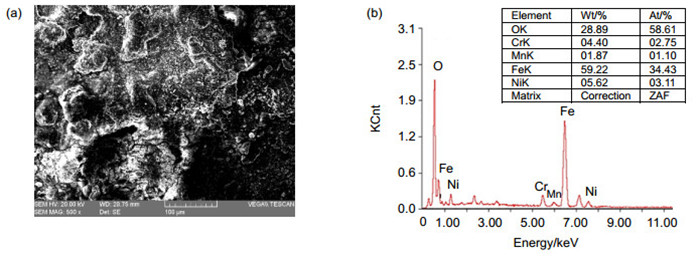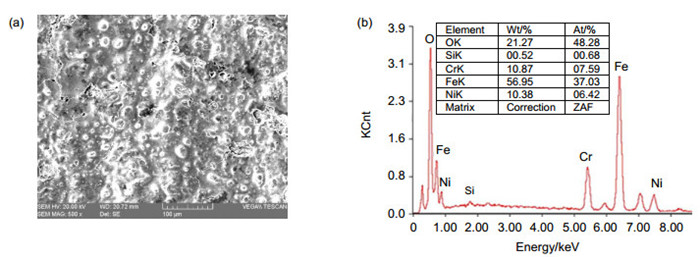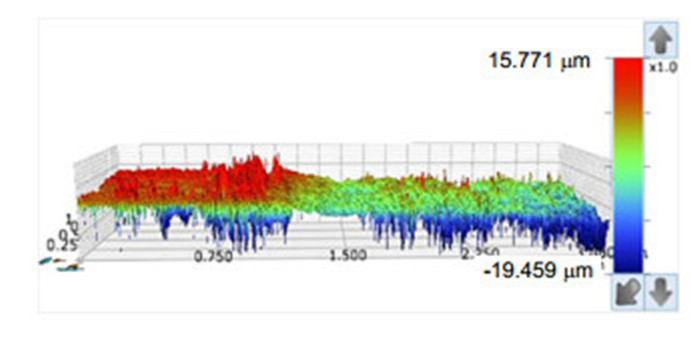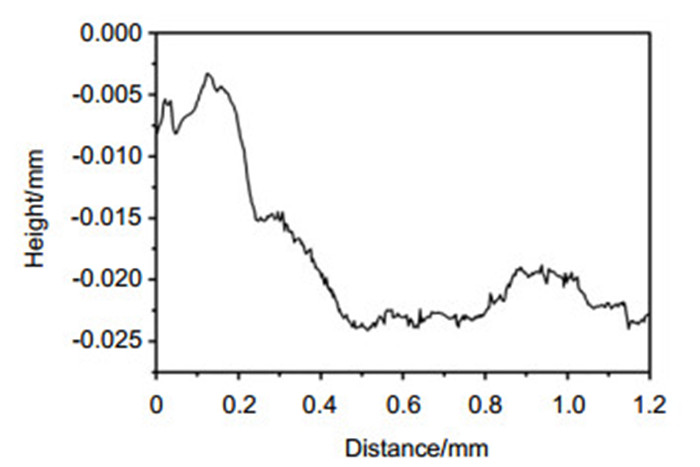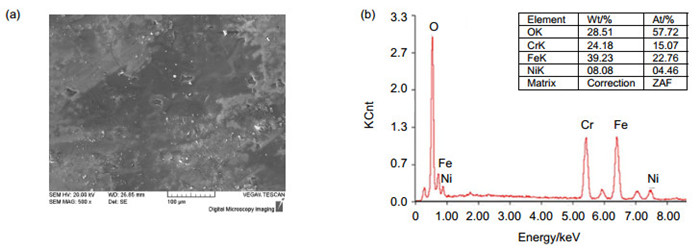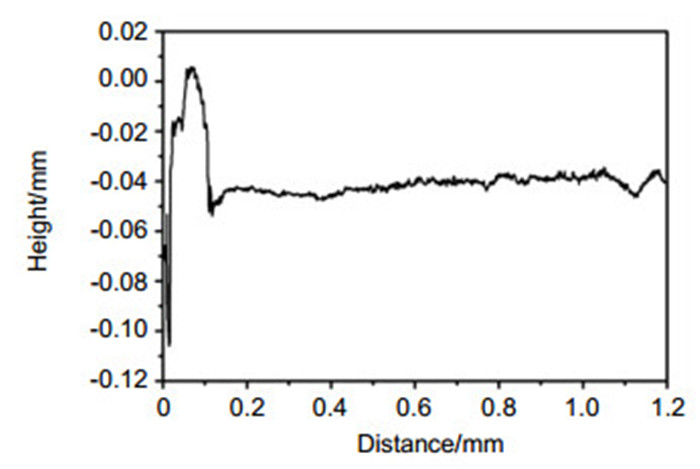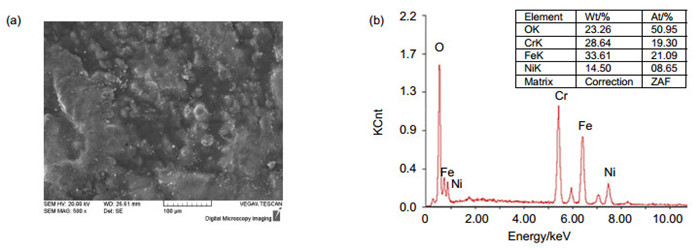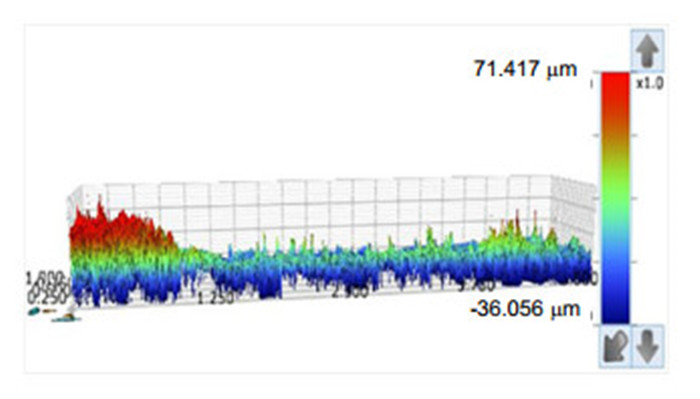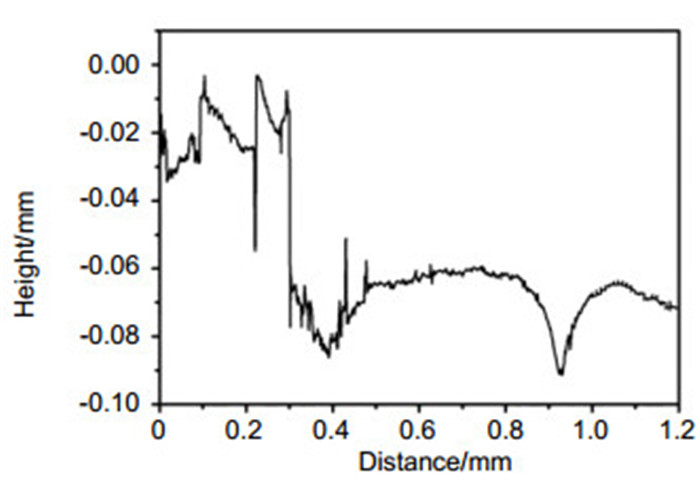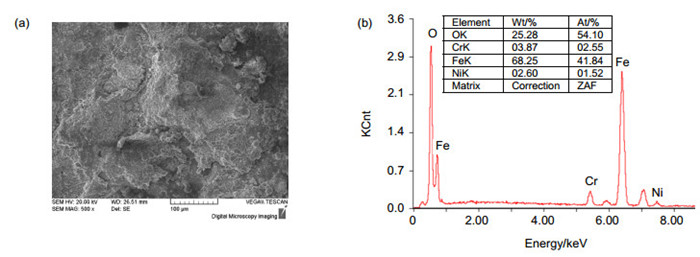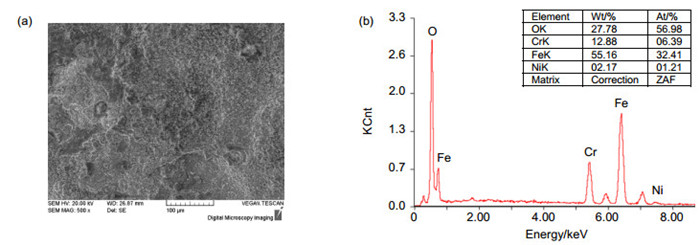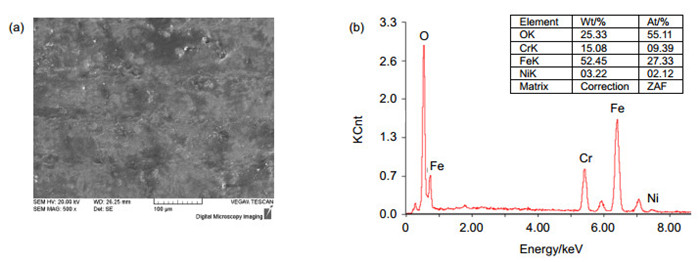-
摘要
利用激光清洗技术对不锈钢表面进行清洗试验,研究不同激光功率(300W、400W、500W)对清洗效果的影响。通过SEM和EDS分析不锈钢表面清洗前后的表面形貌及成分分布;利用白光干涉仪检测不锈钢表面粗糙度及清洗厚度。结果表明,随着激光功率的增加,不锈钢表面氧化物逐渐分解剥落,清洗厚度不断加深,在500W时达到50pm,并且造成基体部分损伤;粗糙度值先降低后增加,在400 W时达到最低值0.38 pm。激光清洗的清洗阈值近似为3.96×103 W/cm2,基体损伤阈值在5.52×103 W/cm2左右,不锈钢表面氧化层在400W时达到最佳激光清洗效果。

Abstract
Laser cleaning technology was used to clean the surface of stainless steel, and the influence of different laser power (300 W, 400 W, 500 W) on cleaning effect was studied. The surface morphology and composition dis tribution of stainless steel were analyzed by SEM and EDS. The surface roughness and cleaning thickness were detected by White Light Interferometer. The results show that, with the increase of laser power, the oxide of stainless steel decomposes and flakes gradually, and the cleaning thickness keeps deepening and reaches 50 pm at 500 W, which causes partial damage to the matrix. The roughness value decreases firstly and then increases. It reaches a minimum value of 0.38 pm at 400 W. Laser cleaning threshold is approximately 3.96×103 W/cm2, and damage threshold is about 5.52×103 W/cm2 The best laser cleaning effect of stainless steel is obtained when the power is 400 W.
-
Key words:
- laser cleaning /
- stainless steel oxide layer /
- laser power /
- roughness /
- cleaning thickness
-
Overview

Laser cleaning has been widely used in many industrial fields because of its high efficiency and no second waste. From this point of view, laser cleaning has promising applications for removal of corroded layer in stainless steel pipe in nuclear plants, compared with conventional chemical and mechanical methods. In this work, systematic laser cleaning experiment of oxide on stainless steel was conducted, and the effect of different laser power (300 W, 400 W, 500 W) on cleaning effect was studied, which obtained the optimum processing parameters on this account. The surface morphology and composition distribution of stainless steel are analyzed by SEM and EDS before and after laser cleaning. The surface roughness was measured by white light interferometer and the removal thickness of oxide was evaluated by the sectional step height. The main results show that: 1) the oxide of stainless steel decomposes and flakes gradually with the increase of power, and the substrate is partly damaged while power exceeds 400 W. The amount of oxide increases instead at 500 W, because high power can cause laser ablation, resulting in a serious oxidation of the matrix; the content of element is mainly O and Fe at 300 W, and then the content of Cr increases continuously and is consistent with that of substrate finally; 2) The cleaning removal thickness increases from 17 μm to 50 μm with laser power; 3) The roughness value Ra is 3.44 μm before laser cleaning, while the roughness value decreases firstly and then increases, and reaches a minimum value of 0.38 μm at 400 W after cleaning; 4) The cleaning force produced by laser cleaning is the key to decontamination. Power density is the concrete data representation of cleaning force. The value of cleaning threshold and damage threshold is obtained by combining power density and experimental analysis. In order to get more accurate data, the experiments of other power (250 W, 280 W, 350 W, and 380 W) are carried out as supplementary. The oxide of stainless steel begins to expand and peel off under a 280 W laser, thus the cleaning threshold is approximately equal to the power density at this point, which is 3.96×103 W/cm2.The laser cleaning starts to touching substrate and causes some damage to it when the power increases to 380 W, which is similar to that of 400 W. Therefore, the average power density of 380 W and 400 W is determined as the damage threshold, and the specific value is 5.52×103 W/cm2. While the power is about 400 W, frequency is 10 kHz, speed is 30 °/h, scan frequency is 5 times, and the laser cleaning obtains the best effect after comprehensive comparison and analysis.
-

-
表 1 304不锈钢化学成分(质量分数,%).
Table 1. Chemical composition of 304 stainless steel (wt, %).
C Cr Ni Mn Si S Fe ≤0.08 18.0~20.0 8.0~10.0 ≤2.0 ≤1.0 ≤0.03 Bal 表 2 试验用激光参数.
Table 2. Laser parameters for test.
参数 值 激光器类型 脉冲 输出中心波长/nm 1064 单脉冲能量/mJ 50 单脉冲宽度/ns 100 功率调节范围/W 100~500 重复频率调节范围/kHz 2~50 转盘速度/(º·h-1) 0~45 光斑直径/mm 3 -
参考文献
[1] 阮競芸.论激光清洗在文物维修中的应用[J].科技与创新, 2014(22): 1-2. doi: 10.3969/j.issn.2095-6835.2014.22.001 http://kns.cnki.net/KCMS/detail/detail.aspx?filename=kjyx201422002&dbname=CJFD&dbcode=CJFQ
Ruan Jingyun. On the laser cleaning applications in relics maintenance[J]. Science and Technology & Innovation, 2014(22): 1-2. doi: 10.3969/j.issn.2095-6835.2014.22.001 http://kns.cnki.net/KCMS/detail/detail.aspx?filename=kjyx201422002&dbname=CJFD&dbcode=CJFQ
[2] 叶亚云, 袁晓东, 向霞, 等.用激光清洗金膜表面硅油污染物[J].强激光与粒子束, 2010, 22(5): 968-972. http://industry.wanfangdata.com.cn/dl/Detail/Periodical?id=Periodical_qjgylzs201005006
Ye Yayun, Yuan Xiaodong, Xiang Xia, et al. CO2 laser cleaning of dimethylsilicone contamination on gilded film surface[J]. High Power Laser And Particle Beams, 2010, 22(5): 968-972. http://industry.wanfangdata.com.cn/dl/Detail/Periodical?id=Periodical_qjgylzs201005006
[3] 宋峰, 刘淑静, 颜博霞.激光清洗——富有前途的环保型清洗方法[J].清洗世界, 2004, 20(5): 43-48, 60. http://mall.cnki.net/magazine/Article/HXQX200405011.htm
Song Feng, Liu Shujing, Yan Boxia. Laser cleaning[J]. Cleaning World, 2004, 20(5): 43-48, 60. http://mall.cnki.net/magazine/Article/HXQX200405011.htm
[4] Pleasants S, Kane D M. Laser cleaning of alumina particles on glass and silica substrates: Experiment and quasistatic model[J]. Journal of Applied Physics, 2003, 93(11): 8862-8866. doi: 10.1063/1.1572541
[5] 陈林, 杨永强.激光清洁技术及其应用[J].红外与激光工程, 2004, 33(3): 274-277. http://d.wanfangdata.com.cn/periodical_xjjs200306005.aspx
Chen Lin, Yang Yongqiang. Laser cleaning technology and its applications[J]. Infrared and Laser Engineering, 2004, 33(3): 274-277. http://d.wanfangdata.com.cn/periodical_xjjs200306005.aspx
[6] Li Xiaoguang, Huang Tingting, Chong Angwei, et al. Laser cleaning of steel structure surface for paint removal and repaint adhesion[J]. Opto-Electronic Engineering, 2017, 44(3): 340‒344.
[7] 施曙东, 杜鹏, 李伟, 等.1064 nm准连续激光除漆研究[J].中国激光, 2012, 39(9): 58-64. http://www.opticsjournal.net/abstract.htm?id=OJ120817000418z6C9Fb
Shi Shudong, Du Peng, Li Wei, et al. Research on paint removal with 1064 nm quasi-continuous-wave laser[J]. Chinese Journal of Lasers, 2012, 39(9): 58-64. http://www.opticsjournal.net/abstract.htm?id=OJ120817000418z6C9Fb
[8] 周桂莲, 赵海霞.激光清洗轮胎模具新工艺[J].特种橡胶制品, 2003, 24(5): 39-41. http://www.wanfangdata.com.cn/details/detail.do?_type=perio&id=tzxjzp200305013
Zhou Guilian, Zhao Haixia. New technology of laser cleaning tyre mould[J]. Special Purpose Rubber Products, 2003, 24(5): 39-41. http://www.wanfangdata.com.cn/details/detail.do?_type=perio&id=tzxjzp200305013
[9] 周桂莲, 孙海迎, 汪传生.橡胶模具激光清洗的工艺研究[J].特种橡胶制品, 2008, 29(6): 34-36. http://www.cnki.com.cn/Article/CJFDTOTAL-TZXJ200806008.htm
Zhou Guilian, Sun Haiying, Wang Chuansheng. Research on laser cleaning process to rubber mold[J]. Special Purpose Rubber Products, 2008, 29(6): 34-36. http://www.cnki.com.cn/Article/CJFDTOTAL-TZXJ200806008.htm
[10] 吴东江, 许媛, 王续跃, 等.激光清洗硅片表面Al2O3颗粒的试验和理论分析[J].光学精密工程, 2006, 14(5): 764-770. http://www.gxhx.cbpt.cnki.net/WKB2/WebPublication/wkTextContent.aspx?contentID=&colType=4&yt=2017&st=04
Wu Dongjiang, Xu Yuan, Wang Xuyue, et al. Experimental and theoretical study on laser cleaning Al2O3 particle on silicon wafer surface[J]. Optics and Precision Engineering, 2006, 14(5): 764-770. http://www.gxhx.cbpt.cnki.net/WKB2/WebPublication/wkTextContent.aspx?contentID=&colType=4&yt=2017&st=04
[11] 王宏睿.激光清洗原理与应用研究[J].清洗世界, 2006, 22(9): 20-23. http://d.wanfangdata.com.cn/Periodical_hxqx200609005.aspx
Wang Hongrui. Principle and applied research on laser clean-ing[J]. Cleaning World, 2006, 22(9): 20-23. http://d.wanfangdata.com.cn/Periodical_hxqx200609005.aspx
[12] Siano S, Fabiani F, Pini R. Determination of damage thresholds to prevent side effects in laser cleaning of pliocene sandstone of Siena[J]. Journal of Cultural Heritage, 2000, 1(S1): S47-S53. https://www.sciencedirect.com/science/article/pii/S1296207400001941
[13] 谭东晖, 陆冬生.激光清洗阈值和损伤阈值的研究[J].激光与光电子学进展, 1997, 34(7): 17-20. http://www.wanfangdata.com.cn/details/detail.do?_type=conference&id=355282
Tan Donghui, Lu Dongsheng. Study of laser cleaning threshold and damage threshold[J]. Laser & Optronics Progress, 1997, 34(7): 17-20. http://www.wanfangdata.com.cn/details/detail.do?_type=conference&id=355282
[14] 郭为席, 胡乾午, 王泽敏, 等.高功率脉冲TEA CO2激光除漆的研究[J].光学与光电技术, 2006, 4(3): 32-35. http://kns.cnki.net/KCMS/detail/detail.aspx?filename=gxgd200603009&dbname=CJFD&dbcode=CJFQ
Guo Weixi, Hu Qianwu, Wang Zemin, et al. Paint removal research on high power pulse TEA CO2 laser[J]. Optics & Optoelectronic Technology, 2006, 4(3): 32-35. http://kns.cnki.net/KCMS/detail/detail.aspx?filename=gxgd200603009&dbname=CJFD&dbcode=CJFQ
[15] 陈菊芳, 张永康, 许仁军, 等.轴快流CO2激光脱漆的实验研究[J].激光技术, 2008, 32(1): 64-66, 70. http://industry.wanfangdata.com.cn/dl/Detail/Patent?id=Patent_CN201511018936.8
Chen Jufang, Zhang Yongkang, Xu Renjun, et al. Experimental research of paint removement with a fast axis flow CO2 laser[J]. Laser Technology, 2008, 32(1): 64-66, 70. http://industry.wanfangdata.com.cn/dl/Detail/Patent?id=Patent_CN201511018936.8
[16] 孔令兵. 激光清洗橡胶制品模具机理的研究[D]. 青岛: 青岛科技大学, 2008.
Kong Lingbing. Study on the mechanism of cleaning rubber products mold by laser[D]. Qingdao: Qingdao University of Science & Technology, 2008.
[17] 伍强, 杨永强, 徐兰英.激光深熔焊接下临界功率密度的确定[J].华南理工大学学报(自然科学版), 2009, 37(8): 71-75. http://www.wanfangdata.com.cn/details/detail.do?_type=perio&id=hnlgdxxb200908014
Wu Qiang, Yang Yongqiang, Xu Lanying. Determination of critical power density of laser deep-penetration welding[J]. Journal of South China University of Technology (Natural Science Edition), 2009, 37(8): 71-75. http://www.wanfangdata.com.cn/details/detail.do?_type=perio&id=hnlgdxxb200908014
-
访问统计


 E-mail Alert
E-mail Alert RSS
RSS
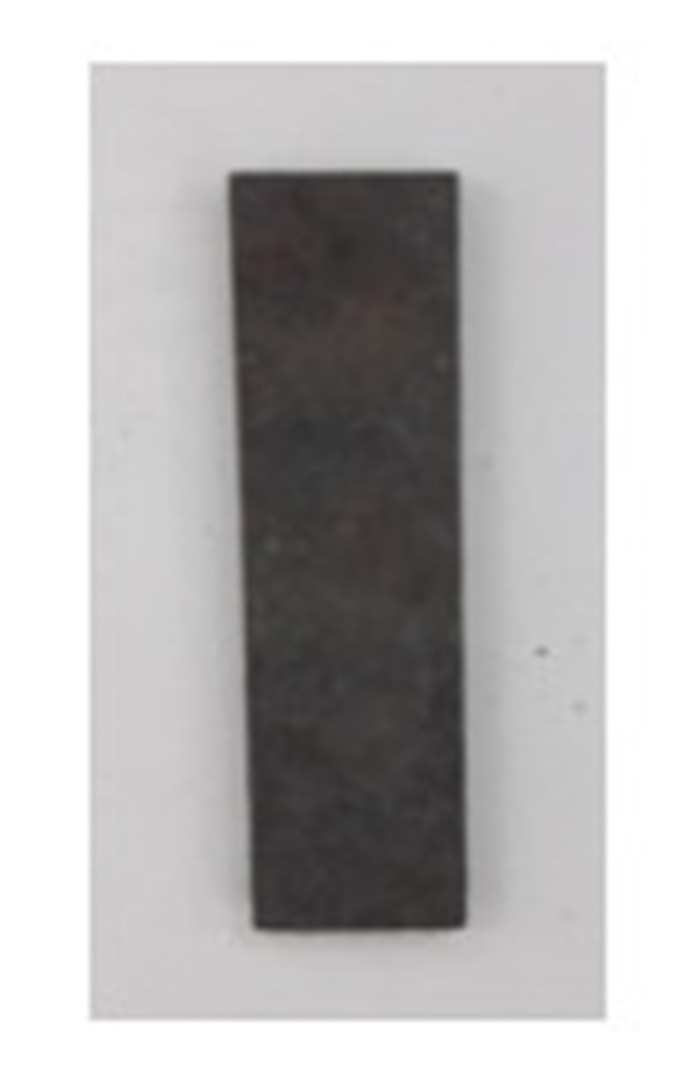
 下载:
下载:

